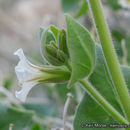Comprehensive Description
(
Inglês
)
fornecido por North American Flora
Hesperonia tenuiloba (S. Wats.) Standley, Contr. U. S. Nat
Herb. 12: 363. 1909.
Mirabilis tenuiloba S. Wats. Proc. Am. Acad. 17: 375. 1882.
Plants erect, very stout, 3-6 dm. high, suffrutescent at the base, much branched, the branches very stout, whitish, densely short-villous or puberulent and viscid, the internodes mostly longer than the leaves, the nodes swollen; petioles stout, 2-7 mm. long, the upper blades subsessile; leaf -blades orbicular-deltoid, broadly deltoid-ovate, or rhombic-ovate, 2.5-4 cm. long, 1.3-3.5 cm. wide, subcordate or rounded at the base, acute or attenuate at the apex or the lower blades rarely obtuse, thick and fleshy, bright-green, densely viscidpuberulent, the upper leaves only slightly smaller than the lower; peduncles 2 mm, long or shorter, axillary, nearly concealed by the subtending leaves; involucre 10-13 mm. long, narrowly campanulate, densely short-villous and very viscid, the lobes slightly unequal, slightly exceeding the tube, narrowly lance-oblong, acute or attenuate; perianth 12-15 mm. long 235
(white ?), glandular-puberulent outside; stamens equaling the perianth; fruit oval in outline, 5 mm. long, 3,5 mm. in diameter, rounded at both ends, dark-brown, smooth.
Type locality: San Bernardino County, California.
^ Distribution: In dry, sandy soil, Colorado Desert of southern California and northern I^ower California.
- citação bibliográfica
- Paul Carpenter Standley. 1918. (CHENOPODIALES); ALLIONIACEAE. North American flora. vol 21(3). New York Botanical Garden, New York, NY
Comprehensive Description
(
Inglês
)
fornecido por North American Flora
Hesperonia tenuiloba (S. Wats.) Standley, Contr. U. S. Nat
Herb. 12: 363. 1909.
Mirabilis tenuiloba S. Wats. Proc. Am. Acad. 17: 375. 1882.
Plants erect, very stout, 3-6 dm. high, suffrutescent at the base, much branched, the branches very stout, whitish, densely short-villous or puberulent and viscid, the internodes mostly longer than the leaves, the nodes swollen; petioles stout, 2-7 mm. long, the upper blades subsessile; leaf-blades orbiculardeltoid, broadly deltoid-ovate, or rhombic-ovate, 2.5-4 cm. long, 1.3-3.5 cm. wide, subcordate or rounded at the base, acute or attenuate at the apex or the lower blades rarely obtuse, thick and fleshy, bright-green, densely viscidpuberulent, the upper leaves only slightly smaller than the lower; peduncles 2 mm. long or shorter, axillary, nearly concealed by the subtending leaves; involucre 10-13 mm. long, narrowly campanulate, densely short-villous and very viscid, the lobes slightly unequal, slightly exceeding the tube, narrowly lance-oblong, acute or attenuate; perianth 12-15 mm. long (white ?), glandular-puberulent outside; stamens equaling the perianth; fruit oval in outline, 5 mm. long, 3.5 mm. in diameter, rounded at both ends, dark-brown, smooth.
Type locality: San Bernardino County, California.
Distribution: In dry, sandy soil, Colorado Desert of southern California and northern Lower California.
- citação bibliográfica
- Paul Carpenter Standley. 1918. (CHENOPODIALES); ALLIONIACEAE. North American flora. vol 21(3). New York Botanical Garden, New York, NY

